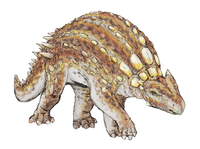
Minmi (dinosaur)
Background to the schools Wikipedia
SOS Children offer a complete download of this selection for schools for use on schools intranets. Do you want to know about sponsoring? See www.sponsorachild.org.uk
| Minmi Temporal range: Early Cretaceous |
|
|---|---|
 |
|
| Scientific classification | |
| Kingdom: | Animalia |
| Phylum: | Chordata |
| Class: | Sauropsida |
| Superorder: | Dinosauria |
| Order: | Ornithischia |
| Suborder: | Thyreophora |
| Infraorder: | Ankylosauria |
| Genus: | Minmi Molnar, 1980 |
| Species | |
|
|
Minmi, named for Minmi Crossing, Australia (where it was found), is a genus of small ankylosaurian dinosaur that lived during the early Cretaceous Period, about 119 to 113 million years ago. Previously holding the record for the shortest dinosaur name, the title now goes to Mei, a carnivore from China that was named in 2004. Two good specimens have been described, including a mostly complete skeleton, and additional fragments may pertain to this genus.
Discovery and species
Minmi was found near the Minmi Crossing, in the Bungil Formation, near Roma, Queensland, Australia. It was first described in 1980 by Ralph E. Molnar.
Paleobiology
Minmi was a small armored dinosaur, part of the ankylosaur group (too primitive to be included in either the Ankylosauridae or Nodosauridae), that was quadrupedal and had a long tail. As with other ankylosaurs, Minmi was herbivorous, eating low-lying plant material like cycads, ferns, and horsetail rushes. It had bony protrusions, also known as body armor, on its head, back, abdomen, legs and along the tail. However, unlike other ankylosaurs, Minmi had horizontal plates of bones that ran along the sides of its vertebrae (hence its species name, M. paravertebra).
Minmi had four long (for an ankylosaurian) legs, with hind legs that were larger than front legs, a short neck and a wide skull with a very small brain. The dinosaur grew to about 3 m (10 ft) long and was roughly 1 m (3 ft) tall to the top of the shoulder. Minmi probably moved relatively slowly on four legs, as determined by scientists from fossilized tracks, its estimated mass and its leg length.


